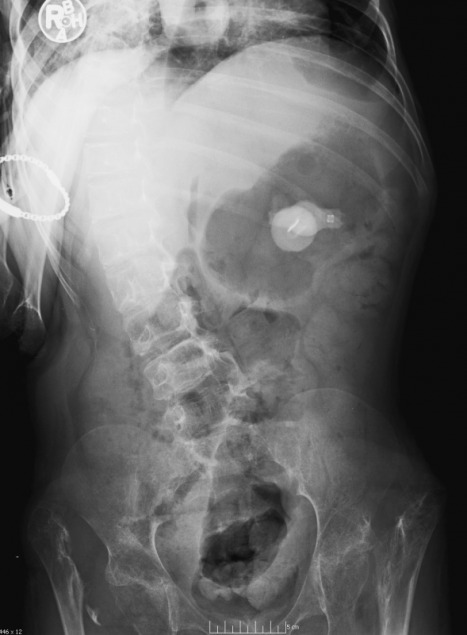An obvious finding is the presence of light bulbs in the gastric region with prominent air in the stomach. Being that we’re entering the holiday season, this case is presented, in part, as a reminder to pay attention to children playing around with the decorations of the season.Looking beyond the foreign bodies in the stomach, the remaining findings include diffuse osteopenia and a right convex thoracolumbar scoliosis. Also noted are dysplastic changes at the hips bilaterally – the femoral heads and necks are not developed bilaterally and there are bilateral hip dislocations. The acetabula are also poorly formed bilaterally.
Differential diagnosis: At first guess, one might suggest bilateral developmental dysplasia of the hip (DDH) or perhaps proximal focal femoral deficiency (PFFD). However the differential needs to be expanded include disorders which may present with all 3 key findings - the scoliosis, osteopenia, and hip changes. This will include neuromuscular disease such as cerebral palsy and congenital disorders such as spondyloepiphyseal or spondylepimetaphyseal dysplasia. Neuromuscular disorders and dysplasia both have unique clinical features which may be useful for differentiation.
Diagnosis – Cerebral palsy (CP)
There are 4 traditional subtypes of CP, the most common of which is the spastic type. In spastic CP, changes in the skeleton are the sequelae of hypertonia which produces impaired neuromuscular mobility. The lack of the “normal” muscular stresses on the skeleton during development results in changes which primarily affect the spine and pelvis. Some patients with CP, as in this case, may show characteristics of Pica, the ingestion of foreign substances.
Treatment – Current treatment is aimed at treating and preventing complications that result from the broad spectrum of changes associated with the disorder. In spastic CP this may include antispasmodic medications, botox, selective rhizotomy, or surgical release of spastic musculature. Orthopedic correction of the hips is generally only considered if the patient is ambulatory. Osteotomy may be performed in some cases with long bone deformity.
Foreign body ingestion is a complication in conditions characterized by severe developmental disability. This may be due to a combination of factors including a prolonged oral phase seen in children with developmental delay, motor skill impairment and oral and pharyngeal dysphagia, as well as verbal and cognitive impairment. Communication of choking or dysphagia in affected child may be limited. A sudden change in appetite including sudden refusal to eat solid foods and possibly even refusal to drink and other sudden changes in behavior associated with meal time should increase the clinical suspicion for an ingested foreign body.
Differential diagnosis: At first guess, one might suggest bilateral developmental dysplasia of the hip (DDH) or perhaps proximal focal femoral deficiency (PFFD). However the differential needs to be expanded include disorders which may present with all 3 key findings - the scoliosis, osteopenia, and hip changes. This will include neuromuscular disease such as cerebral palsy and congenital disorders such as spondyloepiphyseal or spondylepimetaphyseal dysplasia. Neuromuscular disorders and dysplasia both have unique clinical features which may be useful for differentiation.
Diagnosis – Cerebral palsy (CP)
There are 4 traditional subtypes of CP, the most common of which is the spastic type. In spastic CP, changes in the skeleton are the sequelae of hypertonia which produces impaired neuromuscular mobility. The lack of the “normal” muscular stresses on the skeleton during development results in changes which primarily affect the spine and pelvis. Some patients with CP, as in this case, may show characteristics of Pica, the ingestion of foreign substances.
Treatment – Current treatment is aimed at treating and preventing complications that result from the broad spectrum of changes associated with the disorder. In spastic CP this may include antispasmodic medications, botox, selective rhizotomy, or surgical release of spastic musculature. Orthopedic correction of the hips is generally only considered if the patient is ambulatory. Osteotomy may be performed in some cases with long bone deformity.
Foreign body ingestion is a complication in conditions characterized by severe developmental disability. This may be due to a combination of factors including a prolonged oral phase seen in children with developmental delay, motor skill impairment and oral and pharyngeal dysphagia, as well as verbal and cognitive impairment. Communication of choking or dysphagia in affected child may be limited. A sudden change in appetite including sudden refusal to eat solid foods and possibly even refusal to drink and other sudden changes in behavior associated with meal time should increase the clinical suspicion for an ingested foreign body.
